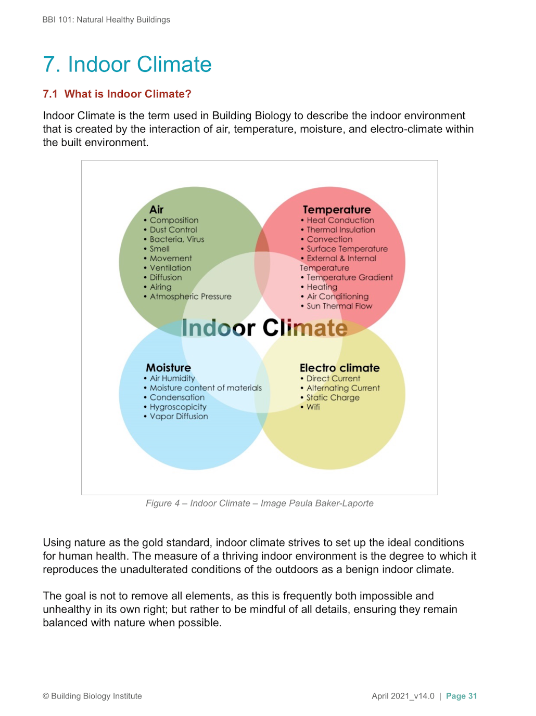Indoor climate is comprised of 4 major components:
- Air
- Temperature
- Moisture
- Electro-climate
To understand all of the elements that impact the indoor environmental quality, one must understand the indoor climate as a whole. This goes far beyond simple indoor air quality; it encompasses the overall atmospheric conditions. It involves factors like temperature, humidity, ventilation and air circulation. As shown in the diagram, these components all overlap and interact.
Two examples of how this plays out:
- A bacteria, for example, and its presence in the environment, is impacted by the temperature in the building and the moisture content.
- In high EMF environments, certain molds are more prevalent.
These examples illustrate the interplay of the four elements within an indoor environment. An in-depth exploration of these four components provides valuable insights into improving the indoor climate for the well-being of the residents.
The goal of a healthy indoor climate is not the complete elimination of all elements, as this is often both unattainable and unhealthy in itself. Instead, the goal is to be mindful of these elements and maintain a balance that mimics nature where possible, as nature serves as the gold standard.
The indoor climate is dynamic. It changes based on usage patterns, occupants, outdoor conditions, and seasonal variations, along with the elements within its components. The element of concern may not necessarily be the root cause of a problem, but rather an effect of another element or condition deviating from normal levels. It is important to understand the building as a living system. Its components and elements within the indoor climate are fluid and interdependent.
AIR
The air component involves a comprehensive breakdown of the chemical, biological, and particulate elements within the indoor environment. It is essential to measure, understand, and mitigate these metrics for optimal indoor air quality. Other elements to consider are movement, ventilation and diffusion.
TEMPERATURE
The intricacies of temperature and its dynamics within the indoor environment go beyond a simple number on a thermostat. Insulation, conduction, convection, radiation, surface temperatures, and various other factors contribute to establishing a comfortable thermal indoor climate. We analyze temperature in terms of its measurable aspects and its influence on the other components and elements of the indoor climate.
Temperature is a measure of the warmth or coldness of a substance, whether it be air, water, or a material. It’s a scaled measure, expressed in Celsius or Fahrenheit, indicating whether a substance is hot or cold. This definition, although seemingly simple, is accurate; temperature itself does not measure heat, as heat is a function of the energy within a substance.
Extreme temperatures, whether they be too hot or too cold, can impact occupant health. Minor temperature variations impact occupant comfort. Some people are more sensitive to temperature changes than others.
Air temperature is commonly represented by Dry Bulb Temperature (DBT), measured on a thermometer with unobstructed exposure to the air while shielded from radiation and moisture.
Thermometers are easily purchased at various price points for use. The more expensive thermometers are more accurate and do not vary in accuracy over years of usage.
Ensure the thermometer is not exposed to a breeze, that it is in a representative location within the room, and it avoids direct sunlight. There must be adequate airflow around the thermometer when taking a reading. When using a thermometer in any environment, it is recommended to let it sit for five minutes to adjust to the ambient conditions within the space.
MOISTURE
Similar to temperature, moisture is more complicated than you might think. One must understand hygroscopicity, vapor drive, condensation, and other details to comprehend relative humidity, how to measure it, and its relation to an overall healthy indoor climate.
ELECTRO-CLIMATE
The electro-climate includes Direct Current (DC) exposures, both electric and magnetic, whether human-made or naturally occurring. The presence of Alternating Current (AC) exposures also includes electric and magnetic fields within the indoor environment. High-frequency exposures such as Wi-Fi, cell phones, smart meters, and other sources have a negative impact on the indoor climate.
HUMIDITY
Relative Humidity (RH) is the measure of water vapor present in the air, expressed as a percentage of the maximum amount the air can hold at a given temperature. When the temperature changes, relative humidity changes. This happens because the capacity of the air for holding moisture increases with increasing temperature. Cold air has a lower capacity for holding moisture compared to hot air. As the temperature rises, the air can accommodate more moisture. Conversely, reducing the temperature with the same amount of moisture in the air increases the relative humidity until it reaches 100%, leading to condensation.
Optimal room humidity for health is (35%-55%). When optimal humidity levels are maintained throughout the year, the home will feel cooler in the summer and warmer in the winter. The air humidity in most buildings, especially during the heating season, is far too low (about 20%-30%).


